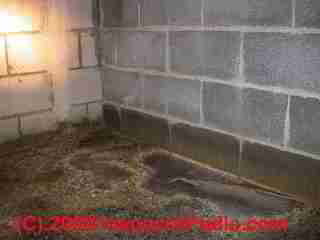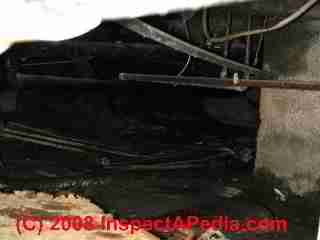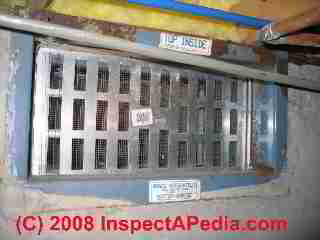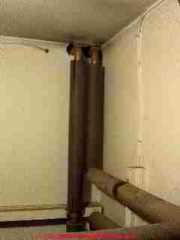 Stop Ongoing or Recurrent Crawl Space Water Entry
Stop Ongoing or Recurrent Crawl Space Water Entry
- POST a QUESTION or COMMENT about how to dry out a wet crawl space & prevent future crawl space water entry
Stop crawl space water entry:
How to stop water from entering a building crawl space.
Here we explain the three basic approaches to stopping crawl space leaks & water entry. This article series describes the steps needed to get into, inspect, clean, and then dry out a building crawl space.
InspectAPedia tolerates no conflicts of interest. We have no relationship with advertisers, products, or services discussed at this website.
- Daniel Friedman, Publisher/Editor/Author - See WHO ARE WE?
How to Stop Ongoing Crawl Space Water Entry
 Stop water from entering the crawl space from outside sources
Stop water from entering the crawl space from outside sources
This means attend to roof gutters and downspouts - the most common cause of crawl space water entry or high moisture in most areas.
[Click to enlarge any image]
Our page top photo shows frozen water in a wet and cold crawl space below a condominium in Poughkeepsie, New York. The very wet masonry blocks along the rear wall of the crawl area and water stains higher on these walls tell us where the water is coming from.
The photo at left shows another crawl space with standing water.
If a building site is unusually wet or springs are adjacent to the building foundation, additional steps such as the installation of a drainage system and sump pump inside or exterior foundation drainage and waterproofing could be necessary.
But before pursuing those costly measures, be absolutely certain that roof runoff and surface runoff have been directed well away from the building.
Inspect the building exterior, from roof to ground, for sources of water that need to be directed away from the structure.
Watch out: by far the most common source of crawl space water entry is improper handling of roof runoff. Spilling water along the building foundation wall because gutters are clogged, leaky, or absent, concentrates water in that location, ultimately overwhelming any foundation drain system.
Don't assume that just because gutters and downspouts are installed that they are working properly. Look more closely for signs of gutter overflow, clogged or leaky downspouts, drip lines under the roof eaves and similar clues.
At GUTTERS & DOWNSPOUTS we include roof drainage system inspection & diagnosis details.
If you see water stains high on the crawl space foundation wall it's a good guess that water is entering from either roof spillage by the foundation or by in-slope grade directing surface water against the building.
See GRADING, DRAINAGE & SITE WORK.
Also see BASEMENT WATERPROOFING and
see FOUNDATION WATERPROOFING that discuss various methods used to keep water and excessive moisture out of buildings or to get rid of water that has leaked into a building.
Stop water from entering the crawl space from inside sources
- Inspect the building interior,
attic to basement and crawl spaces, also looking for sources of leaks, moisture, improper venting, that could affect the structure. In the basement and crawl spaces, look for visual evidence of the pattern of water entry - where has water been entering the building?
Trace that water to its source and cause. - Inspect the crawl space itself
for clues pointing to water entry sources. We list a number of these below, including actual wet conditions, condensation on pipes, under flooring, on foundation walls; foundation wall stains, presence of sump pumps or other drainage systems, odors, visible mold.
Watch out: as we detail at CRAWL SPACE SAFETY ADVICE, entering a wet crawl area is dangerous, involving shock hazards and possible chemical or sewage contaminants.
And see our complete list of crawl space dryout steps at
CRAWL SPACE DRYOUT
- Repair any leaks in building drains
over or in the crawl space.
Check below bathrooms, kitchens, and also check hot water heating lines or steam condensate return lines in the crawl space.
Watch out: sewage-contaminated crawl areas are unsafe to enter without protective gear unless the space has been properly cleaned and disinfected.
See CRAWL SPACE SEWAGE CLEANUP - Repair any leaks in supply piping in the crawl space.
- Insulate cold water pipes
in the crawl space to stop dripping of condensation that forms on the cold water lines in humid weather. It's a good idea to do this in the basement too.
See CONDENSATION or SWEATING PIPES, TANKS
Also see FREEZE-PROOF A BUILDING.
Should you ventilate the crawl space ?
 Crawl space venting – this is a debated topic as in humid weather venting outside air into a cool crawl space might increase crawl space moisture.
Crawl space venting – this is a debated topic as in humid weather venting outside air into a cool crawl space might increase crawl space moisture.
We no longer recommend simple passive venting nor humidistat-controlled venting except in special circumstances.
When our onsite inspection indicates a long-standing moisture problem in such an area the best current advice is to stop venting the crawl space and to convert the crawl space to a dry, conditioned space.
That means we close off crawl space vents, dry out the area, and add some heat to it.
At CRAWL SPACE DEHUMIDIFICATION we explain the use of heat, dehumidifiers, or crawl space exhaust vents to try to improve the humidity level in crawlspaces.
Crawl space venting practices and building codes specifying crawl space vent areas also discussed
at CRAWL SPACE GROUND COVERS.
Watch out: in some conditions, dust containment, negative air, and more protective gear or help from professionals may be needed.
This article series describes the steps needed to get into, inspect, clean, and then dry out a building crawl space.
We give a step by step crawl space entry, inspection, cleanout, dryout and keep dry guide explains how to get into or inspect a crawl space even if there is no ready access, how to assess crawl space conditions, how to stop water that is entering the crawl area, how to dry out the space, how to clean up and if necessary disinfect or sanitize the crawl space, and how to keep out crawl space water and moisture in the future.
...
Reader Comments, Questions & Answers About The Article Above
Below you will find questions and answers previously posted on this page at its page bottom reader comment box.
Reader Q&A - also see RECOMMENDED ARTICLES & FAQs
On 2017-07-06 - by (mod) -
Given the distance and the dim view from here in Venice, I can only all free sound guesses. If you search our website inspectApedia.com for PUMP RUNs FOR NO REASON or for INTERMITTENT PUMP CYCLING, you will see the common causes for the pump behavior that you described. It's possible that there is a leak in the well piping that's creating the water that you see, or even condensation on piping, though I doubt that there would be enough condensation to actually produce puddles or large wet areas.
If you have an opportunity to inspect the space under the building when the water system has been turned off for quite some time that was B diagnostic. If you still see that it's wet I would be looking for a first a problem with the roof or surface runoff. Dtarting with the article on this page above, wr also have a series of articles on how to dry out a crawl space that list all of the common water sources
On 2017-07-05 by Brock
Hello, thanks for all the great info on wells, pumps..etc. I've been reading and reading on your site but I'm confused on some things.
I have a 60 year old 3 season cabin located in Colorado. About 7 summers ago we started seeing some water in crawl space on the side closest to where the pipe comes in from the well. Unfortunately we didn't spend time solving this then and now the problem has gotten a lot worse. We've been told that the water could be a result of a high water table during the spring and should taper off into summer.
This could be true, as it does settle down as the summer go by. If this is what is going on, then maybe a french drain is in order?
The funny thing though is that the water has only been an issue in recent years. So I'm wondering if something else is going on like a well problem?
Also, and this may be an unrelated problem, but the pump does cycle on and off when no water is running. We hear it all night when sleeping. Also the water coming from the faucets has a slight rusty appearance.
The well is located approximately 5 feet from the cabins exterior in the middle of a dirt driveway. So I was also wondering if the well casing was cracked, corroded or had a hole, could this cause flooding in crawlspace? or the well pipe?
Thanks - Brock
Question: how much will it cost me to dry out my crawl space?
hey first off great site, very informative.
I have a 450 sq.ft. crawl space accessed directly from a living space basement. It is clean and dry with gravel and stuff all over the place.
I just bought the place and I was thinking maybe I should just have someone put french drain system around the perimeter there and put a 20 mill poly, a sump pump and just pour concrete all over (saw that online and thought is a good idea)and last spray foam the walls and joists.
My question is how much roughly would all that cost me and do you think it is a great idea to do so.
thank you so much for your advise. - Walden 11/1/2012
Reply:
Walden,
The cost to install an interior perimeter drain in your crawl space depends mostly on
- the area covered
- the ease of access - entry and headroom
- the condition of the surface - e.g. if it is not level or doesn't slope to a drain location
- ease of disposition - to where water has to be pumped
- extent of wiring done
- need for backup power
Figure anywhere from $500 to $5000 for an area I know nothing about
I think I would first look for the history of water entry, signs of moisture trouble, ease of fixing outside sources of water entry, and other crawl space moisture sources and weigh those against the cost for this insurance..
...
Continue reading at CRAWL SPACE WATERPROOFING or select a topic from the closely-related articles below, or see the complete ARTICLE INDEX.
Or see these
Recommended Articles
- CRAWL SPACE DRYOUT - home
Suggested citation for this web page
CRAWL SPACE WATER ENTRY STOP at InspectApedia.com - online encyclopedia of building & environmental inspection, testing, diagnosis, repair, & problem prevention advice.
Or see this
INDEX to RELATED ARTICLES: ARTICLE INDEX to CRAWL SPACES
Or use the SEARCH BOX found below to Ask a Question or Search InspectApedia
Ask a Question or Search InspectApedia
Try the search box just below, or if you prefer, post a question or comment in the Comments box below and we will respond promptly.
Search the InspectApedia website
Note: appearance of your Comment below may be delayed: if your comment contains an image, photograph, web link, or text that looks to the software as if it might be a web link, your posting will appear after it has been approved by a moderator. Apologies for the delay.
Only one image can be added per comment but you can post as many comments, and therefore images, as you like.
You will not receive a notification when a response to your question has been posted.
Please bookmark this page to make it easy for you to check back for our response.
IF above you see "Comment Form is loading comments..." then COMMENT BOX - countable.ca / bawkbox.com IS NOT WORKING.
In any case you are welcome to send an email directly to us at InspectApedia.com at editor@inspectApedia.com
We'll reply to you directly. Please help us help you by noting, in your email, the URL of the InspectApedia page where you wanted to comment.
Citations & References
In addition to any citations in the article above, a full list is available on request.
- [2] Product literature and MSDS sheets for the biocides and fungicidal sealants listed in this article.
- [3] US Centers for Disease Control, CDC: www.cdc.gov/ncidod/diseases/hanta/hps/ describes the risks associated with hantavirus.
- Thanks to reader C. Brown for suggesting the need for detail about rapid dryout procedures for a wet crawl space
- WEATHER RESISTIVE BARRIERS [PDF] U.S. Department of Energy, ", how to select and install housewrap and other types of weather resistive barriers
CONTINUE READING or RECOMMENDED ARTICLES.
- Carson, Dunlop & Associates Ltd., 120 Carlton Street Suite 407, Toronto ON M5A 4K2. Tel: (416) 964-9415 1-800-268-7070 Email: info@carsondunlop.com. Alan Carson is a past president of ASHI, the American Society of Home Inspectors.
Thanks to Alan Carson and Bob Dunlop, for permission for InspectAPedia to use text excerpts from The HOME REFERENCE BOOK - the Encyclopedia of Homes and to use illustrations from The ILLUSTRATED HOME .
Carson Dunlop Associates provides extensive home inspection education and report writing material. In gratitude we provide links to tsome Carson Dunlop Associates products and services.


